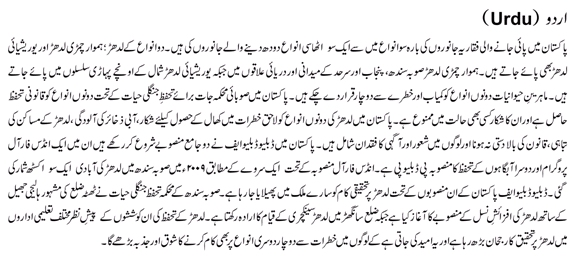IUCN/SSC Otter Specialist Group Bulletin

|
IUCN/SCC Otter Specialist Group Bulletin Volume 27 Issue 2 Pages 59 - 122 (June 2010) Citation: Khan, W.A. and Bhagat, H.B. (2010). Otter Conservation In Pakistan. IUCN Otter Spec. Group Bull. 27 (2): 89 - 92 Otter Conservation In Pakistan Waseem Ahmad Khan1 and Hussain Bux Bhagat2 1WWF Pakistan, 60 – Bazar Road, G – 6/4, Islamabad, Pakistan. e-mail: khanwa@hotmail.com |
  |
|
Abstract:This note describes the conservation status and threats of the two otter species described in Pakistan; Smooth coated otter (Lutrogale perspicillata sindica) and the Eurasian or common otter (Lutra lutra). It also briefly describes the actors involved as well as the efforts made for its conservation. |
| Keywords: Lutrogale perspicillata, Lutra lutra conservation Pakistan |
| Française | Español | Urdu |
Pakistan being located at western ends of Indian subcontinent and having various habitat types, hosts a mixture of Palaearctic, Oriental and Ethiopian fauna. Its vertebrate fauna is comprised of more than 1200 species with 120 (10%) endemic species. It is a unique feature that shows the zoogeographical importance of the country. Mammalian fauna of the country includes 188 species and sub-species representing 10 orders (Insectivora, Chiroptera, Primates, Pholidota, Carnivora, Perrisodactyla, Artiodactyla, Lagomorpha, Rodentia and Cetacea).
Otter Species in Pakistan
Two otter species exist in Pakistan: the Smooth coated otter (Lutrogale perspicillata sindica) (Figure 1) and the Eurasian or common otter (Lutra lutra). The Eurasian otter occurs in the northern mountainous region while the Smooth coated otter occurs in the Sindh, Punjab and North West Frontier Province (NWFP) of Pakistan (Roberts, 1997; Khan et al., 2009). A few reports of hunters also show the existence of the Smooth coated otter in Balochistan (pers. comm.; Mr. Faiz Mohammad, a local conservationist). The sub-species found along the Indus River has been referred as the “Sindh otter” (Lutrogale perspicillata sindica) by Pocock (1940).
 |
| Figure
1. Male Smooth coated otter (Lutrogale perspicillata sindica) at Haleji Lake in the Thatta district, Sindh, Pakistan © WWF Pakistan (click for larger image) |
Conservation Status of Otters in Pakistan
Wildlife conservation movement started in Pakistan during the early 1970’s following the release of a report on the World Wildlife Fund (WWF) expedition to Pakistan (1967) and a report from the Wildlife Enquiry Committee (1971) under the Ministry of Agriculture and Works, Government of Pakistan. But since then only a few practical efforts have been made by wildlife biologists and ecologists to study or update the existing knowledge about mammals in the country. In 1997, Roberts described 188 mammalian species and provided their conservation status in Pakistan, which listed both otter species as being Rare. However, according to a more recent assessment (Sheikh and Molur, 2005) both of the species have been assessed as Near Threatened in Pakistan. Both of the species are protected under Provincial Wildlife Acts being included in 3rd Schedule meaning that cannot be hunted under any circumstance.
Threats to Otters in Pakistan
A major damage caused to otter populations worldwide is from illegal trade of their skins and body parts (IOSF, 2008). Similar is the case with Pakistan where both the species are hunted ruthlessly due to the demand for their fur that has decreased otter populations considerably. Other potential threats to otters in Pakistan include; habitat degradation, water pollution, weak enforcement of wildlife laws, increased tourists’ activities in otter habitats, human-otter conflict upon common fish resources (i.e. food competition among human and otters) and the misconception of its use in medicinal recipes (Khan et al., 2009). Above all is the lack of awareness about importance and ecological role of the species even among the educated people.
Conservation Measures for Otters in Pakistan
WWF Pakistan took the leading role in otter conservation in Pakistan and launched an informal otter awareness and conservation campaign in 2008. Subsequently, several conservationists from different governmental and non-governmental organizations have come forward to become practically involved in otter conservation.
Role of WWF Pakistan
Indus for All Program and Pakistan Wetlands Program (PWP) are two major programs of WWF Pakistan with the former concerned with the conservation of the Indus Eco-region while the later concerns itself with the conservation of more than 200 wetlands throughout the country.
Indus for All Program, as a component of its conservation activities,has been focusing on three threatened wildlife species; the Marsh crocodile (Crocodilus palurus), the Hog deer (Axis porcinus) and the Smooth coated otter (Lutrogale perspicillata) as the species of special concern from the Indus eco-region. It intends to conserve these species through habitat restoration, relocation, and management with the help of local communities. In this context, Indus for All Program has also funded a 2-year project for the conservation and management of Smooth coated otters in Indus Eco-region to the Sindh Wildlife Department (SWD). Under one of the project activities, the population of Smooth coated otter has been estimated to 161 individual recently (Khan and Qasim, 2010) in Indus Eco-region.
PWP has launched distributional studies in NWFP for the Eurasian otter and in the Punjab province for the Smooth coated otter with the intention to expand these studies up to Gilgit-Baltistan in northern Pakistan. PWP has also designed a poster showing paintings and brief write ups about the otter species found in Pakistan. Facilitating three conservationists from Pakistan to attend the Otter Training Workshop in Cambodia during February 2009 is another valuable contribution of the PWP towards otter conservation.
Role of Sindh Wildlife Department
SWD is playing a leading role in otter conservation in Sindh Province with its most important initiative towards otter conservation being the establishment of a Conservation Breeding Center at Haleji Lake in the Thatta district which is not yet fully functional but currently serves as an Information Center for students, researchers and general public. SWD is also planning the establishment of Wildlife Sanctuary for otters in the Sanghar district this year which will be the first ever otter sanctuary in Pakistan.
Conclusion
As a result of the otter conservation campaign in recent years, three students in three different universities in the country are now doing their PhD and Ms. phil. research on otters. More than five research and popular articles about otters have been published recently in Pakistan and a similar number of articles are presently being prepared. It is hoped that these initiatives about otters will lead other conservationists towards other threatened wildlife species in the country as well.
REFERENCES
IOSF (2008). Alarming Trade in Otter Fur. IOSF. 7 Black Park, Bradford, Isle of Skye, IV49 9DE, Scotland. 11 pp.
Khan, W.A., Qasim, M., Ahmad, E., Akbar, G., Habib, A.H., Ali, H., Qamar, F. M., Chaudhry, A.A., Iqbal, S., Bhaagat, H.B., Akhtar, M. and Ahmad, M.S. (2009). A Survey of Smooth coated otter (Lurogale perspicillata sindica) in Sindh, Province of Pakistan. IUCN Otter Specialist Group Bulletin 26 (1): 15-31.
Khan, W.A. and Qasim, M. (2010). Otter Survey in Indus Eco-region: Otter Population Estimation. WWF Pakistan, Internal Report 167 pp.
Pocock, R.I. (1940). Notes on some British Indian Otters with descriptions of two new subspecies. J. Bombay Nat. Hist. Soc, 41:514-518.
Roberts, T.J. (1997). The Mammals of Pakistan. Revised Edition, Oxford University Press, 5-Bangalore Town, Shara e Faisal, Karachi. 525 pp.
Sheikh, K.M. and Molur, S. (2005). Status and Red List of Pakistan’s Mammals. IUCN Pakistan. 344 pp.
Résumé : Conservation de la Loutre au Pakistan
Deux espèces de loutres subsistent au Pakistan, la Loutre à pelage lisse (Lutrogale perspicillata sindica) et la Loutre d'Europe (Lutra lutra). Rares et protégées, les menaces pesant sur elles sont celles communément répandues à travers le monde: chasse illégale pour la fourrure et la pharmacopée, destruction des habitats, compétition avec l'Homme sur la pêche et un manque d'éducation sur leur rôle et leur importance écologique fait défaut. Le WWF a lancé une campagne d'information en 2008 suivi d'un programme de conservation de Loutre à pelage lisse dans la région de l'Indus où 161 individus semblent subsister. Aujourd'hui, divers organismes régionaux s'investissent progressivement dans la conservation ex situ et in situ de ces espèces et des étudiants en font leurs sujets d'études.
Revenez au dessus
Resumen: Conservacion de la Nutria en Pakistan
Esta nota describe el estatus de conservación y las amenazas que se posan sobre las dos especies de nutria en Pakistan: la nutira lisa (Lutrogale perspicillata sindica) y la nutria común o Euroasiática (Lutra lutra). Adicionalmente describe las entidades relacionadas y los efuerzos realizados para su conservación en el país.
Vuelva a la tapa
Urdu:

Top